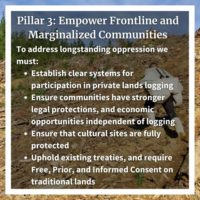
Climate change is currently the greatest and most formidable threat that we face as a planet. The science supporting climate change is conclusive and repeatedly borne out by myriad weather anomalies and arctic ice patterns, as well as biological phenomenon such as altered timing of migrations and species’ distributions.
Cascadia Wildlands recognizes the immediate need to take action to lower atmospheric greenhouse gases and bring the climate back to a stable condition. We take a two-pronged approach to combating climate change, which includes both halting the fossil fuel industry’s emissions of greenhouse gasses, and defending Cascadia’s forests, which are some of the best in the world for storing carbon.

Defending Cascadia’s Forests:

Healthy forests have an incredible capacity for storing carbon, and the forests of western Cascadia are some of the best in the world for carbon sequestration. In fact, the Oregon Global Warming Commission’s Forest Carbon Task Force found that each year, Oregon forests take in between 23 and 63-million tons of carbon dioxide, making them unmatched in their ability to store carbon.
Old-growth forests of the Pacific Northwest store more carbon per unit area than any other biome, anywhere on Earth. Much of this carbon is tied up in the huge trees. The regional temperate climate creates ideal soil conditions and properties that hold secrets to why these trees grow so big. Soil acts as a ‘black box’ in forest ecosystems because the vital processes are hidden underground. Soil fertility, or the ability of soil to provide plants with sufficient nutrients and water, is not visually obvious, but it can be measured using scientific methods and analytical equipment. — United States Geological Survey (USGS) Forest and Rangeland Ecosystem Science Center, Unearthing Secrets of the Forest Factsheet
Logging is the number one source of emissions in the state of Oregon, and emits far more carbon than transportation or residential and commercial sectors (Law et al. 2018). While similar research has not been completed in Washington and California, we can assume that logging in these states have similar climate impacts. Studies have also shown that, if left unlogged, forests of the Pacific Northwest could sequester massive amounts of carbon from the atmosphere and significantly contribute to global efforts to mitigate the climate crisis (Buotte et al. 2019). Groups across the region are rallying around a Green New Deal for Pacific Northwest Forests in order to protect these invaluable carbon stores.
Unfortunately, Cascadia is also home to an aggressive logging industry that often disregards the incredible capacity of our forests. Aggressive timber management and clearcut-plantation logging practices not only undercut the ability for Cascadia’s forests to store carbon, but also contribute hugely to greenhouse gas emissions. Indeed, the timber industry is Oregon’s biggest climate polluter. Defending Cascadia’s forests, such as the remarkable Elliott State Forest, is essential work toward combating climate change and supporting natural processes of bringing atmospheric carbon levels back to stable quantities.
Click here to learn more about our work defending Cascadia’s forests.
A Green New Deal for Pacific Northwest Forests:
In June 2021, over fifty forest and climate justice organizations across northern California, Oregon, and Washington released a sweeping Green New Deal for Pacific Northwest Forests platform calling for the transformation of current forest practices on private, state, and federal land in the face of the climate crisis and ecological collapse. The platform emphasizes the critical role that the forests of the Pacific Northwest must play in efforts to mitigate climate change and to safeguard communities from climate impacts such as wildfire and drought.
The Green New Deal for Pacific Northwest Forests calls not only for a transformation of industrial logging to protect forests, waterways and communities, but also for a jobs guarantee and increased government investments in climate resilience for frontline communities. In line with the intersectional movement for climate justice, the platform outlines a clear path forward for governments at all levels to utilize the invaluable forests of the Pacific Northwest as a tool to address the many crises facing the region and the country.
The six pillars of the Green New Deal for Pacific Northwest Forests address the intersecting issues of industrial logging, climate change, species collapse, economic injustice, and the disempowerment of frontline communities.






More information:
- Read the executive summary.
- Read the proposed platform.
- Visit the coalition website and learn how to join the movement.
- Reporting about the role that Pacific Northwest forests can play in mitigating and adapting to climate change.
- Reporting on strategies to lessen the threat of wildfire to communities across the west.
- Read the U.S. House and Senate resolutions on the Green New Deal.
Transitioning Away from Fossil Fuels:

The Jordan Cove Energy Project: The Jordan Cove Energy Project, which includes the Pacific Connector Pipeline and fracked liquefied natural gas (LNG) export facility is currently the greatest threat to our climate security in the region. The Jordan Cove Energy Project is now a plan by Pembina, a Canadian energy company, to export fracked liquefied natural gas (LNG) from Canada and the Rockies overseas using Oregon as a right-of-way. If built, this 229-mile fracked Gas Pipeline and associated LNG Export Facility would threaten 485 waterways (including the drinking water for over 116,000 Oregonians), seize property from private landowners through eminent domain, create major safety and public health hazards, impact Tribal territories, cultural resources, and burial grounds, and become the largest source of climate pollution in the state. We continue to fight this project tooth and nail and won’t stop until the proposal dies once and for all. THIS PROJECT HAS BEEN CANCELLED!
Why Combating Climate Change Matters:
It is not an overstatement to say that if we are successful in all that we do here at Cascadia Wildlands and we fail to stem human-caused climate change in a material way that we will lose much that we have gained and possibly more.
Although the Pacific Northwest has been identified as an area that will be less impacted than others by climate change, the projected impacts will be profound and, in some instances, simply unacceptable. Projected impacts include:
- The Loss of Pacific Salmon Runs—Warmer waters and reduced snow packs will very likely act together to eliminate migratory salmon and steelhead runs and some resident trout populations. Salmon and steelhead will often not cross stretches of water that are too warm (known as thermal dams) and reduced water volumes will likely block fish transit to and from the ocean at critical times.
- Large Scale Forest Change—We are currently beginning to see climate-driven changes in Northwest forests. For example, lodgepole pine populations are being stressed and reduced by bark beetle infestations that may be facilitated by warmer temperatures. Other species of trees and plants will see range reductions or shifts that could have both biological and economic consequences. Experts also point to climate change creating conditions ripe for larger and more severe wildfires in the West as we have seen in recent years.
- Ocean Acidification—As CO2 levels increase in the atmosphere they also increase in the ocean along with nitrogen and sulfur compounds associated with the burning of coal and other fossil fuels. All of these added chemicals act in concert to increase acidification of the ocean and our coastal waters. Elements of the shell fishing industry in the Pacific Northwest are already seeing retarded shell growth and other fin fisheries will be impacted as the effects move up the food web.
- Agriculture—Climate change deniers have often argued that increasing CO2 levels will only benefit agriculture by increasing growth rates and therefore production. But experience is showing us that the associated heat, droughts, and storm intensities are having a negative impact on crop growth. What’s more, associated acid precipitation may leach nutrients and needed trace minerals faster from soils increasing the need for more costly agricultural input.



